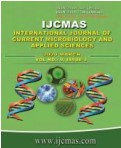


 National Academy of Agricultural Sciences (NAAS)
National Academy of Agricultural Sciences (NAAS)

|
PRINT ISSN : 2319-7692
Online ISSN : 2319-7706 Issues : 12 per year Publisher : Excellent Publishers Email : editorijcmas@gmail.com / submit@ijcmas.com Editor-in-chief: Dr.M.Prakash Index Copernicus ICV 2018: 95.39 NAAS RATING 2020: 5.38 |
In the present investigation, bacterial species such as E. coli, S. aureus and S. bongori were isolated from soil by using serial dilution. Bioremediation results showed the S. aureus was highly efficient on Diazinon removal by 62%, 63.2% and 68.6%, Pirimicarb removal was 44%, 52.4% and 53.8%, and Atrazine removal was 61%, 65.6% and 70.6%. and the efficiency of E. coli removal on Diazinon was 59%, 60.8% and 63.8%; on Pirimicarb was 44%, 52.4% and 53.8%; and for Atrazine 57%, 60.8% and 64.4%. S. bongori efficiency on Diazinon was 49%, 51.2% and 55.8%; on Pirimicarb removal was 61%, 63.2% and 68.4%; Also, in Atrazine removal 48%, 50.4% and 57.2%. When comparing the growth rate of bacterial cells. The bacterial cells before treatment with S. aureus was 22.01×, Results after treatment showed Diazinon of 35.58×. The Pirimicarb 32.41× and Atrazine was 38.45 ×, either E. coli. Its bacterial growth was before treatment 17.09×. To show the results of growth on diazinon 30.43×, Pirimicarb 27.71× and Atrazine 24.34×. While the growth was in S.bongori Before treatment 10.09× While recorded a growth rate on Diazinon 18.82×, Pirimicarb 19.98× and Atrazine 17.08 ×. These bacterial species efficiencies on bioremediation of these three pesticides proved to be promising It can be used safely in the process of removing pesticides, yet more research on safety, mechanisms and kinetics needs to be further investigated.
 |
 |
 |
 |
 |